 W
WL'Arlésienne, L'Arlésienne: Madame Ginoux, or Portrait of Madame Ginoux is the title given to a group of six similar paintings by Vincent van Gogh, painted in Arles, November 1888, and in Saint-Rémy, February 1890. L'Arlésienne means literally "the woman from Arles".
 W
WL'Atelier Rouge, also known as The Red Studio, is a painting by Henri Matisse from 1911, in the collection of The Museum of Modern Art, New York City.
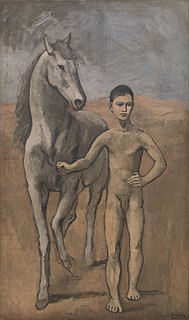 W
WJeune garçon au cheval is an oil on canvas painting by Pablo Picasso. The painting is housed in the Museum of Modern Art in New York City. It was painted in Picasso's Rose Period from 1905 to 1906, when he was still a struggling artist living in Paris. The painting is a study for a much larger composition that Picasso never completed.
 W
WBroadway Boogie Woogie is a painting by Piet Mondrian completed in 1943, after he had moved to New York in 1940. Compared to his earlier work, the canvas is divided into a much larger number of squares. Although he spent most of his career creating abstract work, this painting is inspired by clear real-world examples: the city grid of Manhattan, and boogie-woogie, an African-American Blues music Mondrian loved. The painting was bought by the Brazilian sculptor Maria Martins for the price of $800 at the Valentine Gallery in New York City, after Martins and Mondrian both exhibited there in 1943. Martins later donated the painting to the Museum of Modern Art in New York City.
 W
WCampbell's Soup Cans is a work of art produced between November 1961 and March or April 1962, by American artist Andy Warhol. It consists of thirty-two canvases, each measuring 20 inches (51 cm) in height × 16 inches (41 cm) in width and each consisting of a painting of a Campbell's Soup can—one of each of the canned soup varieties the company offered at the time. The non-painterly works were produced by a screen printing process and depict imagery deriving from popular culture and belong to the pop art movement.
 W
WCanyon is a 1959 artwork by American artist Robert Rauschenberg. The piece is one of his most celebrated and best known works, and is one of his combine paintings, which incorporated elements of sculpture into canvas-based pieces. Canyon features a taxidermied eagle, a pillow, and other elements.
 W
WChristina's World is a 1948 painting by American painter Andrew Wyeth and one of the best-known American paintings of the middle 20th century. It is a tempera work done in a realist style, depicting a woman semi-reclining on the ground in a treeless, mostly tawny field, looking up at a gray house on the horizon; a barn and various other small outbuildings are adjacent to the house. It is owned by the Museum of Modern Art in New York as part of its permanent collection.
 W
WThe City Rises (1910) is a painting by the Italian painter Umberto Boccioni. It was his first major Futurist work.
 W
WDance is a painting made by Henri Matisse in 1910, at the request of Russian businessman and art collector Sergei Shchukin, who bequeathed the large decorative panel to the Hermitage Museum in Saint Petersburg, Russia. The composition of dancing figures is commonly recognized as "a key point of (Matisse's) career and in the development of modern painting". A preliminary version of the work, sketched by Matisse in 1909 as a study for the work, resides at MoMA in New York City, where it has been labeled Dance (I).
 W
WLes Demoiselles d'Avignon is a large oil painting created in 1907 by the Spanish artist Pablo Picasso. The work, part of the permanent collection of the Museum of Modern Art, portrays five nude female prostitutes in a brothel on Carrer d'Avinyó, a street in Barcelona. Each figure is depicted in a disconcerting confrontational manner and none is conventionally feminine. The women appear slightly menacing and are rendered with angular and disjointed body shapes. The figure on the left exhibits facial features and dress of Egyptian or southern Asian style. The two adjacent figures are shown in the Iberian style of Picasso's native Spain, while the two on the right are shown with African mask-like features. The ethnic primitivism evoked in these masks, according to Picasso, moved him to "liberate an utterly original artistic style of compelling, even savage force."
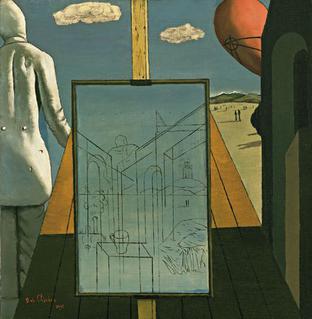 W
WThe Double Dream of Spring is a painting by the Italian metaphysical painter Giorgio de Chirico.
 W
WThe Dream is a large oil-on-canvas painting created by Henri Rousseau in 1910, one of more than 25 Rousseau paintings with a jungle theme. His last completed work, it was first exhibited at the Salon des Indépendants from 18 March to 1 May 1910, a few months before his death on 2 September 1910. Rousseau's earlier works had received a negative reception, but poet and critic Guillaume Apollinaire remarked on its debut: "The picture radiates beauty, that is indisputable. I believe nobody will laugh this year."
 W
WDrowning Girl is a 1963 painting in oil and synthetic polymer paint on canvas by Roy Lichtenstein, based on original art by Tony Abruzzo. The painting is considered among Lichtenstein's most significant works, perhaps on a par with his acclaimed 1963 diptych Whaam!. One of the most representative paintings of the pop art movement, Drowning Girl was acquired by the Museum of Modern Art in 1971.
 W
WDynamism of a Soccer Player is a 1913 Futurist painting by Italian artist Umberto Boccioni (1882–1916). It is currently held in the Museum of Modern Art in New York.
 W
WThe Eiffel Tower series of Robert Delaunay is a cycle of paintings and drawings of the Eiffel Tower. Its main sequence was created between 1909 and 1912, with additional works added up to 1928. The series is considered the most prominent art depicting the iconic Paris tower as well as the most prominent work of Delaunay.
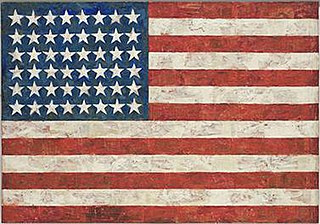 W
WFlag is an encaustic painting by the American artist Jasper Johns. Created when Johns was 24 (1954–55), two years after he was discharged from the US Army, this painting was the first of many works that Johns has said were inspired by a dream of the U.S. flag in 1954. It is arguably the painting for which Johns is best known.
 W
WThe Funeral of the Anarchist Galli is a painting by Italian painter Carlo Carrà. It was finished in 1911, during the artist's futurist phase. It currently resides in New York City's Museum of Modern Art.
 W
WGare Montparnasse (1914) is a painting by the Italian metaphysical painter Giorgio de Chirico. Many of de Chirico's works were inspired by the introspective feelings evoked by travel. He was born in Greece to Italian parents. This work was painted during a period when he lived in Paris.
 W
WGas is a 1940 painting by the American painter Edward Hopper. It depicts an American gas station at the end of a highway.
 W
WGirl with Ball is a 1961 painting by Roy Lichtenstein. It is an oil on canvas Pop art work that is now in the collection of the Museum of Modern Art, after being owned for several decades by Philip Johnson. It is one of Lichtenstein's earliest Pop art works and is known for its source, which is a newspaper ad that ran for several decades and which was among Lichtenstein's earliest works sourced from pop culture.
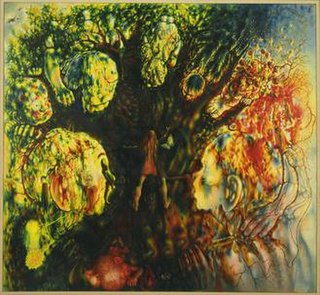 W
WHide-and-Seek is a 1942 oil on canvas painting in the collection of the Museum of Modern Art (MoMA) in New York City, by Russian painter Pavel Tchelitchew.
 W
WHope II is a painting by Gustav Klimt, made in 1907–08. It was the second of Klimt's works to focus on a pregnant woman, both depicting Herma, one of his favourite models. It was entitled Vision by Klimt, but has become known as Hope II after the earlier work Hope, which is now distinguished as Hope I. Hope II was acquired by the Museum of Modern Art in New York City in 1978.
 W
WHopeless is a 1963 painting with oil paint and acrylic paint on canvas by Roy Lichtenstein. The painting is in the collection of the Kunstmuseum Basel.
 W
WI and the Village is an oil on canvas painting by the Belarusian-French artist Marc Chagall created in 1911. It is exhibited at the Museum of Modern Art, New York.
 W
WLandscape at Collioure is a painting by Henri Matisse from 1905, part of the collection of the Museum of Modern Art.
 W
WMap is a 1961 oil-on-canvas painting by Jasper Johns. It represents the overall proportions and shapes of the states of the United States and parts of Mexico and Canada, although executed with a more "energetic application of paint" than found in cartography. The names of the states and ocean areas are stencilled.
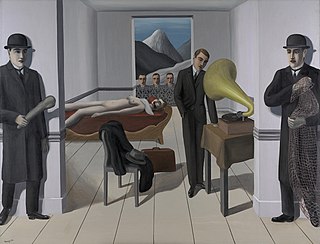 W
WThe Menaced Assassin is a 1927 oil on canvas painting by Belgian surrealist artist René Magritte.
 W
WMercury Passing Before the Sun is the title of a series of paintings by Italian Futurist painter Giacomo Balla, depicting the November 17, 1914 transit of Mercury across the face of the Sun.
 W
WNapoleon in the Wilderness is a 1941 surrealist painting by Max Ernst in the collection of the Museum of Modern Art in New York City.
 W
WNew York Movie is an oil on canvas painting by American Painter Edward Hopper. The painting was begun in December of 1938 and finished in January of 1939. Measuring 32 1/4 x 40 1/8", New York Movie depicts a nearly empty movie theater occupied with a few scattered moviegoers and a pensive usherette lost in her thoughts. Praised for its brilliant portrayal of multiple light sources, New York Movie is one of Hopper's well-regarded works. Despite the fact that the movie in the painting itself is not known, Hopper's wife and fellow painter Josephine Hopper wrote in her notes on New York Movie that the image represents fragments of snow-covered mountains.
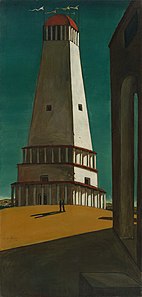 W
WThe Nostalgia of the Infinite is a painting by the Italian metaphysical painter Giorgio de Chirico.
 W
WVincent van Gogh painted at least 15 paintings of olive trees, mostly in Saint-Rémy-de-Provence in 1889. At his own request, he lived at an asylum there from May 1889 through May 1890 painting the gardens of the asylum and, when he had permission to venture outside its walls, nearby olive trees, cypresses and wheat fields.
 W
WOpus 217. Against the Enamel of a Background Rhythmic with Beats and Angles, Tones, and Tints, Portrait of M. Félix Fénéon in 1890 is an 1890 oil painting by French artist Paul Signac. The Neo-impressionist work depicts the French art critic Félix Fénéon standing in front of a swirling coloured background. It has been held by the Museum of Modern Art in New York since 1991.
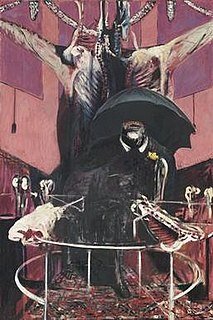 W
WPainting 1946, also known as Painting or Painting (1946), is an oil-on-linen painting by the Irish-born artist Francis Bacon. It was originally intended to depict a chimpanzee in long grass ; Bacon then attempted to paint a bird of prey landing in a field. Bacon described the work as his most unconscious, the figurations forming without his intention. In an interview with David Sylvester in 1962, Bacon recalls:FB:Well, one of the pictures I did in 1946, which was the thing that's in the Museum of Modern Art ... DS:The butcher-shop picture. FB:Yes. It came to me as an accident. I was attempting to make a bird alighting on a field. And it may have been bound up in some way with the three forms that had gone before, but suddenly the line that I had drawn suggested something totally different and out of this suggestion arose this picture. I had no intention to do this picture; I never thought of it in that way. It was like one continuous accident mounting on top of another.
 W
WThe Persistence of Memory is a 1931 painting by artist Salvador Dalí and one of the most recognizable works of Surrealism. First shown at the Julien Levy Gallery in 1932, since 1934 the painting has been in the collection of the Museum of Modern Art (MoMA) in New York City, which received it from an anonymous donor. It is widely recognized and frequently referenced in popular culture, and sometimes referred to by more descriptive titles, such as "Melting Clocks", "The Soft Watches" or "The Melting Watches".
 W
WPicasso's Rose Period represents an important epoch in the life and work of the Spanish artist Pablo Picasso and had a great impact on the developments of modern art. It began in 1904 at a time when Picasso settled in Montmartre at the Bateau-Lavoir among bohemian poets and writers. Following Picasso's Blue Period, depicting themes of poverty, loneliness, and despair in somber tones of daunting blues, Picasso's Rose Period represents more pleasant themes of clowns, harlequins, and carnival performers, depicted in cheerful vivid hues of red, orange, pink and earth tones.
 W
WThe Plum Blossoms is a 1948 painting by Henri Matisse.
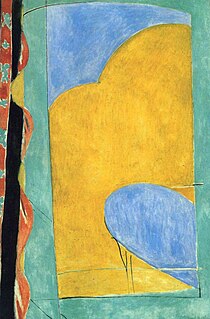 W
WLe rideau jaune is a painting by Henri Matisse created in 1915. Its size is 57½ × 38⅛" . It is currently in the collection of the Museum of Modern Art, New York.
 W
WThe Roulin Family is a group of portrait paintings Vincent van Gogh executed in Arles in 1888 and 1889 on Joseph, his wife Augustine and their three children: Armand, Camille and Marcelle. This series is unique in many ways. Although Van Gogh loved to paint portraits, it was difficult for financial and other reasons for him to find models. So, finding an entire family that agreed to sit for paintings — in fact, for several sittings each — was a bounty.
 W
WThe Sleeping Gypsy is an 1897 oil painting by French Naïve artist Henri Rousseau (1844–1910). It is a fantastical depiction of a lion musing over a sleeping woman on a moonlit night.
 W
WThe Song of Love is a painting by the Italian metaphysical painter Giorgio de Chirico. It is one of the most famous works by de Chirico and an early example of the surrealist style, though it was painted ten years before the movement was "founded" by André Breton in 1924.
 W
WThe Starry Night is an oil on canvas painting by Dutch Post-Impressionist painter Vincent van Gogh. Painted in June 1889, it depicts the view from the east-facing window of his asylum room at Saint-Rémy-de-Provence, just before sunrise, with the addition of an imaginary village. It has been in the permanent collection of the Museum of Modern Art in New York City since 1941, acquired through the Lillie P. Bliss Bequest. Widely regarded as Van Gogh's magnum opus, The Starry Night is one of the most recognized paintings in Western art.
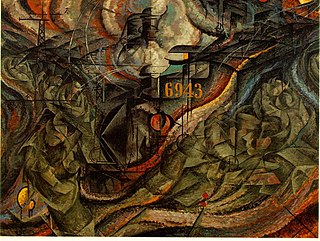 W
WStates of Mind I:The Farewells is the first in a series of three oil paintings by the Italian Futurist painter Umberto Boccioni which are all in the collection of the Museum of Modern Art (MOMA) in New York City. Executed in 1911 and set in a railway station, the three works attempt to depict the psychological aspects of the drama and emotion of modern travel.
 W
WStill Life with Old Shoe is a 1937 oil painting by Joan Miró, now part of the permanent collection of the Museum of Modern Art in New York City. The work was given to the museum by James Thrall Soby in 1970.
 W
WStreet Light is a painting by Italian Futurist painter Giacomo Balla, dated 1909, depicting an electric street lamp casting a glow which outshines the crescent moon. The painting was inspired by streetlights at the Piazza Termini in Rome.
 W
WStreet, Berlin is an oil painting by Ernst Ludwig Kirchner painted in 1913 before the outbreak of World War I. At this time, Kirchner painted several different street scenes that illustrated the chaos of city life and the relationship between men and women.
 W
WThe Spring is a large oil painting created in 1912 by the French artist Francis Picabia. The work, both Cubist and abstract, was exhibited in Paris at the Salon d'Automne of 1912. The Cubist contribution to the 1912 Salon d'Automne created a controversy in the Municipal Council of Paris, leading to a debate in the Chambre des Députés about the use of public funds to provide the venue for such 'barbaric' art. The Cubists were defended by the Socialist deputy, Marcel Sembat. This painting was realized as Albert Gleizes and Jean Metzinger, in preparation for the Salon de la Section d'Or, published a major defence of Cubism, resulting in the first theoretical essay on the new movement, Du «Cubisme». The painting forms part of the permanent collection of the Museum of Modern Art, New York City.
 W
WThree Musicians is the title of two similar collage and oil paintings by Spanish artist Pablo Picasso. They were both completed in 1921 in Fontainebleau near Paris, France, and exemplify the Synthetic Cubist style; the flat planes of color and "intricate puzzle-like composition" echoing the arrangements of cutout paper with which the style originated. These paintings each colorfully represent three musicians wearing masks in the tradition of the popular Italian theater Commedia dell'arte.
 W
WTrophy, Hypertrophied (1919) is a work of art by the German dadaist/surrealist Max Ernst. This is one of Ernst's earliest known works. It was created through a photomechanical process called line-block printing, rarely used in printmaking, to which drawing was added. It depicts a complex mechanical apparatus with celestial shapes as gears. Ernst created a similar piece the same year titled Farewell My Beautiful Land of Mary Laurencen. Help! Help!
 W
WTwittering Machine is a 1922 watercolor and pen and ink oil transfer on paper by Swiss-German painter Paul Klee. Like other artworks by Klee, it blends biology and machinery, depicting a loosely sketched group of birds on a wire or branch connected to a hand-crank. Interpretations of the work vary widely: it has been perceived as a nightmarish lure for the viewer or a depiction of the helplessness of the artist, but also as a triumph of nature over mechanical pursuits. It has been seen as a visual representation of the mechanics of sound.
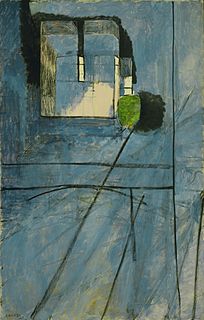 W
WView of Notre-Dame is an oil painting by Henri Matisse from 1914.
 W
WViolon et raisins is a 1912 oil on canvas painting by Pablo Picasso. This painting was one of five works exhibited by the artist at Galerie Goltz, Munich, along with Tête de femme. It is housed in the Museum of Modern Art in New York.
 W
WVir Heroicus Sublimis is a 1951 painting by Barnett Newman, an American painter who was a key part of the abstract expressionist movement. Vir Heroicus Sublimis—"Man, Heroic and Sublime" in Latin—attempts to evoke a reaction from its viewers through its overwhelming scale and saturated color. The painting is part of the permanent collection of the Museum of Modern Art in New York City.
 W
WWater Lilies is a series of approximately 250 oil paintings by French Impressionist Claude Monet (1840–1926). The paintings depict his flower garden at his home in Giverny, and were the main focus of his artistic production during the last thirty years of his life. Many of the works were painted while Monet suffered from cataracts.
 W
WSuprematist Composition: White on White (1918) is an abstract oil-on-canvas painting by Kazimir Malevich. It is one of the more well-known examples of the Russian Suprematism movement, painted the year after the October Revolution.
 W
WWoman on a High Stool is an oil painting on canvas by the French artist Henri Matisse from early 1914. It is a portrait of Germaine Raynal, the wife of the poet and art critic Maurice Raynal. With its simplified geometric structure, dark contouring, and subdued palette, the work relates closely to Paul Cézanne and Cubism.